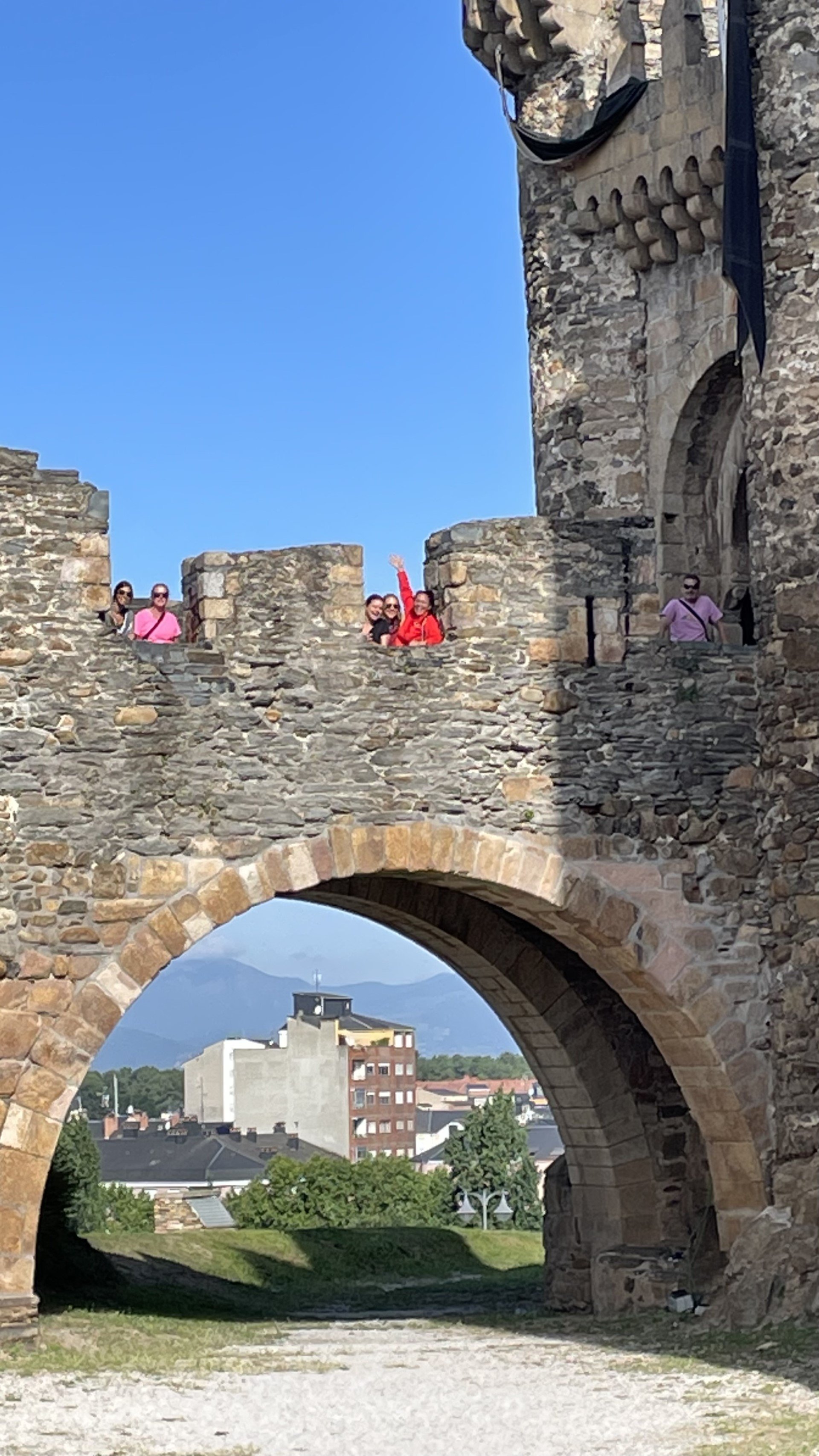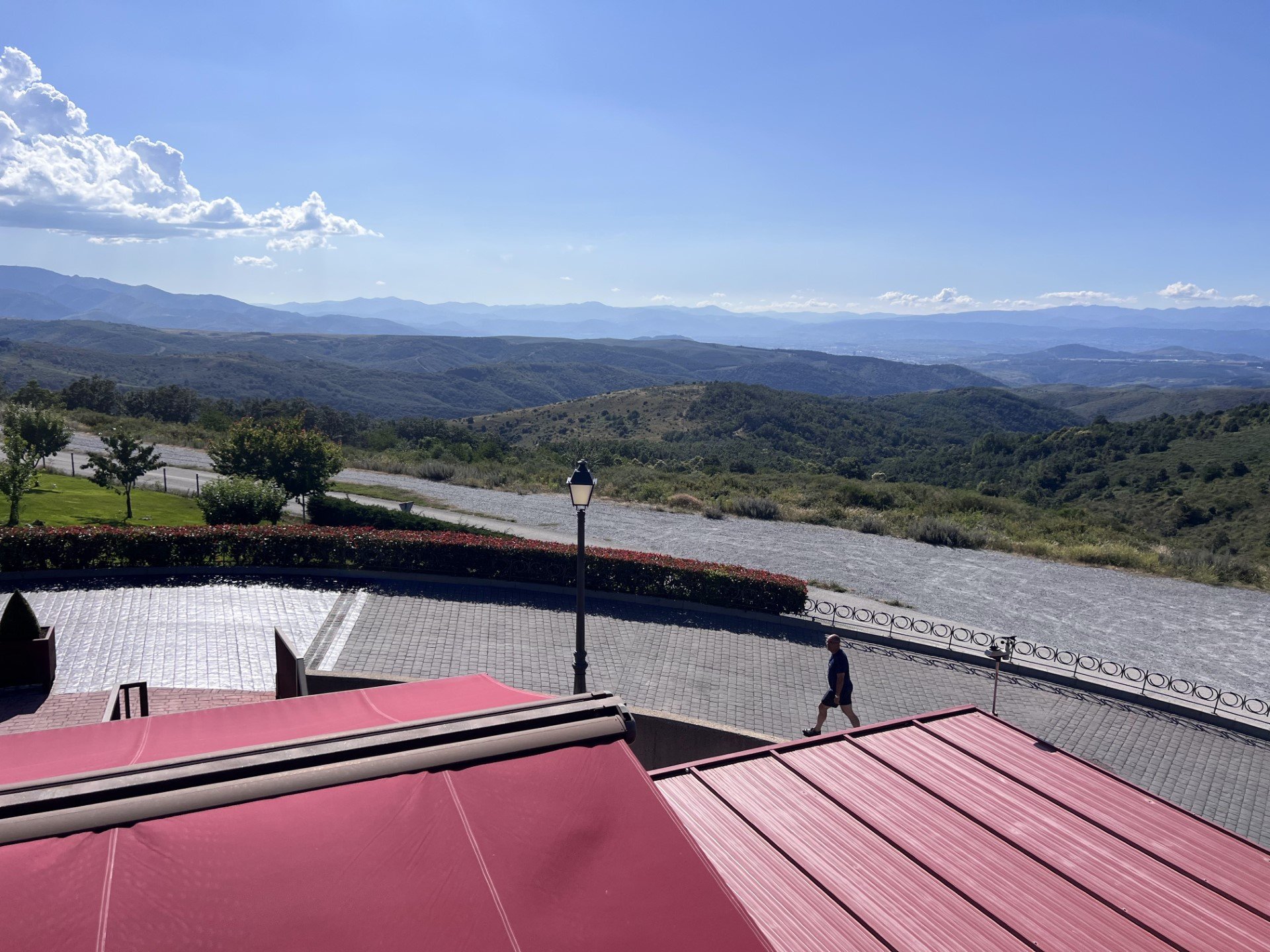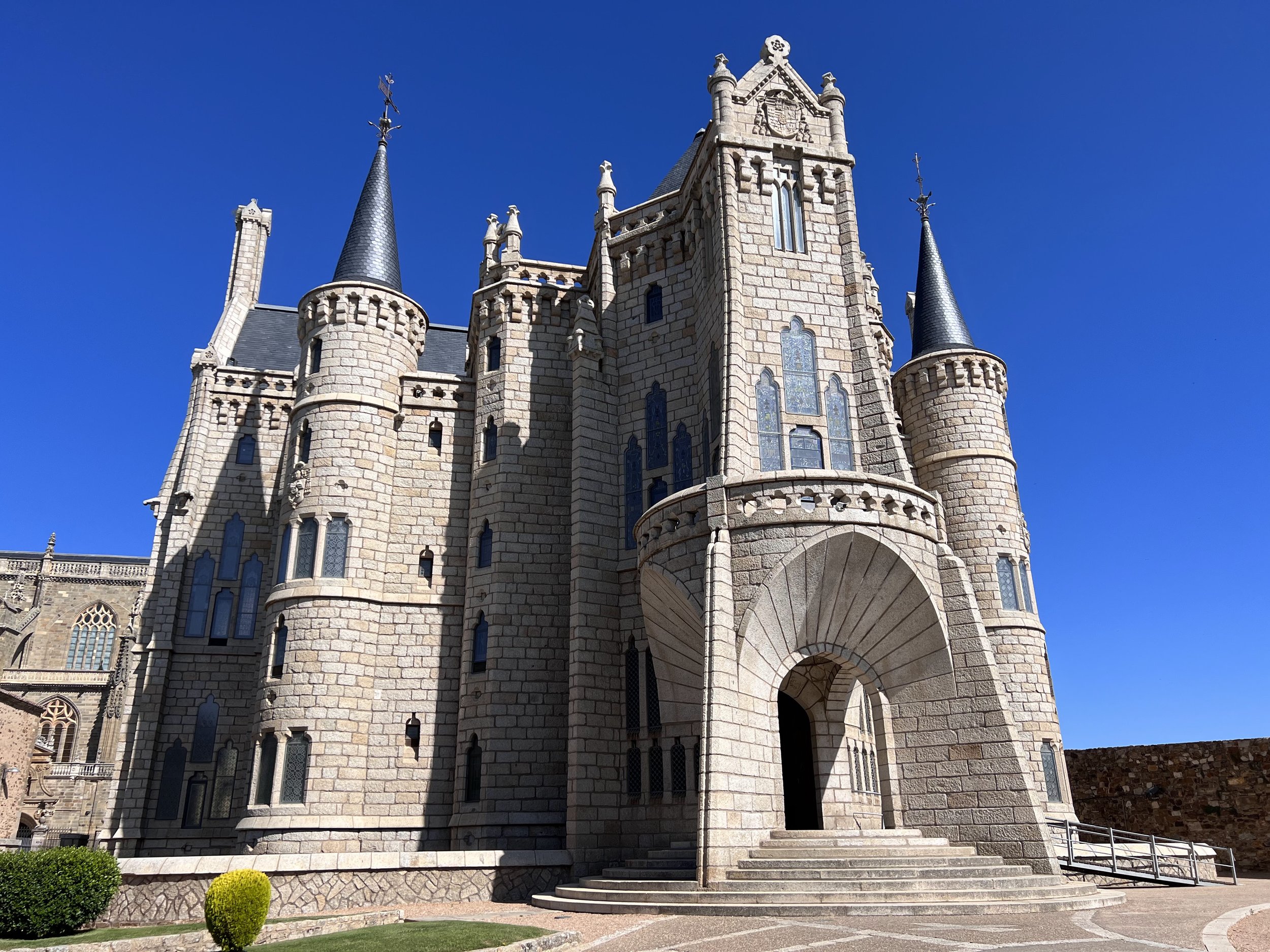Ponferrada
Ponferrada stands for iron bridge and when you walk in the town, you can see a large bridge leading up to a massive castle or fortress. This was one of the important fortresses used by knights templars during the Crusades. With the muslim invasion in 711 into the southern part of the Iberian Peninsula, the Catholic church saw this not just as a political invasion, but as a Holy War. St. James becomes Matamoros because, as the peninsula’s patron saint, stories began to circulate that he would appear miraculously during battles and defeat the infidels or those not on the “right” side. There are numerous paintings and sculptures along the Camino depicting a warrior Santiago on a white horse with fallen muslim warriors being trampled underfoot. The fortress in Ponferrada has an excellent history of the knights and their purpose during the Crusades. They were a religious order sanctioned by the Catholic church that protected the area and kept the invaders from crossing into Galicia. The fortresses location gives it a perfect view of the surrounding area and they successfully kept the muslims from reaching Galicia and Santiago de Compostela.
This town definitely deserves a stop for a castle visit and food. They often have concerts in the evening on the castle grounds if you are staying in town for the night!
El Acebo
The walk itself to El Acebo from Cruz de Ferro isn’t long but it’s pretty steep downhill and with a lot of loose rock. The views are incredible but there isn’t a stop to sit and catch your breath after the break at Cruz de Ferro. The sun beating down during the descent, in my opinion, makes this walk one of the hardest on the Camino. People ask me all the time if they should take walking poles and I think on days like this one, I’m so glad I have my poles for stabilization for my knees.
Once we make it to the small town of El Acebo, the climb, emotions of the day, and the steep descent are all worth it when we see our lodging for the evening. This pilgrim albergue is one of the nicest places on the Camino, in my opinion. We all stay in one room as a family unit and we are each given a bunk. While the sleeping quarters are modest, they are clean and the view is five stars! This place even has a spa, laundry facilities, and a pool.
We checked in and started laundry. On the Camino, we do laundry whenever we can so we usually through all of our things in together. While some opted for a massage, others went straight for the pool. We all showered and ate a delicious communal dinner that rivaled any Michelin starred restaurant in both taste and presentation.
After dinner, we gathered outside to watch the sunset and play cards. Sadly, Quincy was only able to join us for a few days so she took a cab to the next bigger town to get on her bus to Madrid. The rest of us packed our bags for the following day and said our goodnights and goodbyes to the other pilgrims we met at the albergue. Tomorrow, we will cross into Galicia!
Cruz de Ferro
So the adventure begins! Today was the beginning of our Camino de Santiago journey as we wandered up the hills to the famous Cruz de Ferro. A ritual of the Camino pilgrimage, carrying your "burden" stone on The Way and then depositing it at the Cruz de Ferro, is humbling, emotional, and moving. Placing the stone at the foot of the cross symbolizes the release of that burden to invite the freedom to experience the true wonders of the Camino.
I approached the Cruz with mixed emotions as my motivation for participating was as a support and walking partner to my wife who has had walking the Camino on her bucket list for years! Yet as I placed my stone on the pile, I too embraced the emotions of the action and deposited my burden next to many others. Later, as we gathered as a group, we shared, prayed, sang, cried, laughed, and generally reflected the embodied aspect of this activity. Memorable to be sure, we left with our spirits higher.
It's a good thing too because little did we know the amount of hill climbing that lay in front of us! The downward trek was little better, not for lack of beautiful landscape or invigorating conversation, but the path was strewn with small stones that proved to be a walking challenge. In the end, it was all worth the effort as our lone stay in the "albergue" (pilgrim hostel) was incredible! Great food, great location, and even a swimming pool! The only challenge was that as the only male "peregrino" in our group of me and 7 females, the communal bunk arrangement made for a fun night.
All-in-all, an incredible beginning to what went on to become a phenomenal adventure.
~Dean
Astorga
Astorga is a very common place for pilgrims to begin walking because it is right after the meseta or the flatter plateau region of Spain. No shade (pun intended) to the meseta because it is a lovely stage to walk, but Astorga to Santiago is roughly 10 days give or take and if people have limited time, it’s a great starting point. Astorga was a Roman civilization so there are some excellent remains and foundations to visit. In addition, the Astorga Cathedral has an incredible history of the area as well as an extensive library. One addition that was popular among the pilgrims was a virtual reality exhibit inside the cathedral museum.
Next to the cathedral is a house that was originally meant as the bishop’s residence. This impressive house was designed by Gaudi and it’s one of his earlier projects. Now it’s a museum with an impressive collection of items from the original Roman settlers to statues and relics from the Camino de Santiago.
If you have time, you must visit the chocolate museum. You can learn about the history of the factory and buy chocolate there.
Leon
León is such an amazing city with a rich history. Their gothic cathedral rivals the Notre Dame in Paris in my opinion with its incredible stained glass windows. One of our favorite visits in León is the San Isidoro Pantheon and religious library. There is a romanesque fresco that is one of the best preserved depictions of Christ’s life in the world. The library houses some of the oldest Bibles and illustrated manuscripts and it really puts into perspective why so many churches relied on sculptures, altar pieces, and paintings to retell stories from scripture because the books are massive!
The group was joined by another pilgrim in León and we got a walking tour from a Friend of the Camino Society member. He really broke down the importance of León in the Iberian Península especially during the Crusades and leading up to the unification of Spain with Fernando and Isabel. León was also Franco’s capital during the Spanish Civil War.
That evening our guide took us on a tapas tour where we ordered a drink for one euro and got a free appetizer with it. We made a meal out of it by trying several places and sampling their specialty appetizers. No evening in Spain is complete without delicious helado.
Burgos
We got up early and said goodbye to Pamplona and our delicious little cafe with the fresh squeezed orange juice and exquisite cafe con leche. Our first stop was Santo Domingo de la Calzada. This stop is often overlooked because pilgrims are trying to make it to the next stop for the day but it’s full of history and delight! According to the Codex Calixtinus, a miracle occurred here when a young pilgrim who had been wrongly accused and sentenced to death was founding still alive, hanging from the gallows. When his parents ran to tell the governor who was getting ready to eat a chicken, he didn’t believe that the man was still alive. The story goes that he exclaimed that if the man were truly alive, the chicken on his plate would get up and live. Miraculously, the chicken got up and to this day, to commemorate that miracle, a live chicken lives in a gilded cage in the Cathedral! Also, all over the town, you can find little chocolate chickens and images of chickens.
We drove through the Rioja region and the meseta and stopped in Burgos for the day. The Burgos cathedral is spectacular and we spent some time learning its history as well as learning about El Cid, the Spanish Christian conquerer who earned the respect of both the Christians and the Muslims during the Crusades. He and his wife are buried in the cathedral. The lookout in Burgos has the remains of a fortress that was destroyed by the French. We added another pilgrim in Burgos!
St. Jean Pied du Port
St. Jean Pied du Port. O la la!
We left early the next morning and our beloved cab driver took us over the Pyrenees mountains to the bordering town of St. Jean Pied du Port. The tiny French town is so charming and it’s full of shopkeepers eager to help you purchase the best walking stick for the Camino. The people volunteering at the Pilgrim’s office were so helpful as they talked through the different elevation stages in the mountains. Of course, they didn’t know that we weren’t walking over the mountain but it was still nice to hear them tell us where every shelter can be found, and how long we could expect to be walking before we reached our next destination.
Our next stop back into Spain was Roncesvalles where Charlemagne’s army was defeated by the Basque people. The little town of Roncesvalles does not have much in it except a hostel and a church, but it was beautiful and we got an idea how excited a pilgrim would feel once they arrived for the evening.
Our driver got us back to Pamplona in time for us to walk around and see the bull ring where Ernest Hemingway’s statue stands. Hemingway spent time in Pamplona and wrote several books recounting Spanish traditions and practices. Pamplona was gearing up for their Running of the Bulls so there was a lot of excitement in the air.
And we’re off!
And we’re off!
The Camino de Santiago’s French Route in Spain begins at the border town of St. Jean Pied du Port. As a group, we wanted to visit cathedrals, museums, and other historical monuments during the first part of the trip so we hired a car to drive us to our locations until we would walk the last 100K. This journey usually takes at least a month to complete and we knew we only had a limited amount of time to walk. Encounter Travel for Transformation included most of the significant places along the Camino so we could experience a portion of the areas we were unable to walk.
Our first stop was Pamplona. We checked into our hostel and went directly to the Cathedral to learn about the history of the city. Then we explored the city and sat in the Plaza Mayor and observed the community and ate delicious tapas and ice cream.
For more pictures of our time, check out our instagram and facebook pages!
Madrid!
Do not miss this!
I get questions all the time about must see places in Madrid if you only have a couple of days. If you have limited time in Madrid, stay near the city center. I personally like Gran Vía and Callao locations because you have great shopping, and you are only a few minutes from Sol and the Plaza Mayor. I know that many people who are in Spain for the Camino go straight to St. Jean Pied du Port and start walking immediately, but I recommend giving yourself a few days to explore Spain and to adjust to the time change and different meal times.
Our first stop, (after the Mercado San Miguel for some delicious fruit) was the church to get our pilgrim passports and our shells for our backpacks. During mass, the congregation prayed over the pilgrims getting ready to start the Camino.
Our group made it to Madrid at different times so we explored on our own until Wednesday when we explored Plaza Mayor and San Ginés (the best chocolatería that’s open 24 hours).
The following day, we went to the Prado Museum and the Reina Sofía Museum. These are MUST see museums and they are so close that you can walk to the other one. I highly recommend that you spend some time in the Retiro park with a picnic or get a cafe near the lake in the park and relax and people watch.
Of course, Madrid has so much more to see and do but we had to get ready to start exploring the Camino so we focused on art, the architecture of the Royal Palace and surrounding areas, and the delicious food.
Pilgrimage to Santiago. Meet the Pilgrims!
Follow us on the Camino de Santiago!
Encounter’s first official scholarship initiative is the French Way of the Camino de Santiago. The route usually takes 30-35 days from the border of France and Spain to Santiago de Compostela in the far west corner of Spain. Pilgrims walk an average of 20-30 kilometers a day for roughly 800 kilometers. Since we didn’t have that much time, we decided to see a portion of the Camino by car and walk approximately 130 kilometers. The minimum one can walk to receive their Compostelana (pilgrim certificate) is 100k.
Our group is an interesting one. Dean and Kelly Jo have lived all over the world and have recently settled in Phoenix where Dean is an adjunct business instructor. Gayle, Abby, and Riki are professors at a college in Iowa and they’ve all had cross cultural experience. Falecia currently lives in Granada and walked the Camino when she was an undergraduate student. Quincy is a consultant in Chicago and currently serves on the board of directors for Encounters. She was only able to join us for a few days but it was so great to have her. Sharenda rounded out our group as the leader. She has led several students along the Camino Francés.
The group first met up for a few days in Madrid. We wanted to visit some museums and get used to the time change and food before we started moving from place to place. It also allowed for those with cancelled or delayed flights to get into Spain so we could start our Camino as a group. Follow along as we talk about our Camino experience!


















